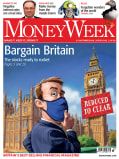Who or what controls market prices?
A clear understanding of how market prices are really set, and the underlying process that determines them, can significantly enhance your trading performance.
Many people are under the illusion that market prices are somehow 'set' or manipulated by large powerful organisations who conspire to push prices their way (usually in the direction contrary to those people's wishes).
Even some traders who have been around the markets for some time do not have a clear understanding of how they really work, and the underlying process that determines price.
I believe that trading performance can be significantly enhanced by gaining such an understanding, so let's look into this.
Subscribe to MoneyWeek
Subscribe to MoneyWeek today and get your first six magazine issues absolutely FREE

Sign up to Money Morning
Don't miss the latest investment and personal finances news, market analysis, plus money-saving tips with our free twice-daily newsletter
Don't miss the latest investment and personal finances news, market analysis, plus money-saving tips with our free twice-daily newsletter
Let's look at the futures market in gold (I've chosen this because the gold market is very hot currently). The US futures markets are among the most openly traded. I started trading the futures markets in the days of open outcry, where the gold traders would congregate in the gold 'pit' of Comex in New York. When the opening bell sounded, they would shout, scream, and wave their arms about, signalling to all in the pit their desire to buy or sell a certain contract month in a certain quantity (of contracts) at a certain price. These orders came to them by phone from outside traders, or they may have traded on their own account.
It was certainly very colourful in those days. Of course, gold futures trading today takes place electronically in the relative peace surrounding your keyboard.
But the basic principles are unchanged.
Following the progress of the completed trades in the pit were observers, who transmitted the constantly-changing prices to the back office, where they were made instantly available to the world. There was, and still is, total transparency of exchange data instant up-to-the second prices, trading volumes, and a range of technical data that are freely available to all.
Now, let's ask the question: what is happening during one of these trades? Let's say the last trade took place at $1,350.00 an ounce. The whole world is aware of this trade (on spread-betting platforms, that is the last price shown). In that trade, there was a buyer and a seller (or several matched at that price).
What are the motivations at work? The buyer wants to buy because they believe prices will rise, and they want to profit from this assumed rise; or they may be short, taking a loss, and want to cut their loss; or they may want to protect the value of their paper currencies (a popular theme today!) there are many motivations that might drive a buyer of gold.
But here's what we know for a fact: the buyer wants to buy at the lowest possible price.
If you offered them gold at $1,300, they would snap your hand off.
What about the seller? Well, the seller wants to sell because they believe prices will fall, and they want to cover at a lower assumed price; or perhaps they are long and wish to cash in their profit; or maybe they don't know what else to do with their investment funds, and have read a bearish article (it does happen!).
But again, here's something we know for a fact: the seller wants to sell at the highest possible price.
If their offer selling gold at $1,400 is accepted, they would be delighted.
So if buyers and sellers have diametrically opposed interests, then what is it that makes them both compromise and trade with each other? Because that is what a trade is a compromise.
Let's go back to that last gold trade at $1,350. All it takes for the next trade to take place is for the next set of buyers to give in and place their orders to buy at the market, and the sellers to do likewise. If the volume of 'buy' orders exceeds the volume of 'sell' orders at that point, then the price agreed will be higher perhaps $1,350.20.
This is the important point: The decision of those buyers and sellers when they decide to compromise is largely an emotional one. This was amply displayed in the open-outcry Comex pits, I can assure you! During active sessions, traders would emerge sweating and sometimes blooded, as pencils often found their way into the next guy's face.
It is this constant flow of buy and sell orders by compromising buyers and sellers that cause the price to constantly fluctuate. And this is important to remember the last price determines the next one.
Traders are influenced by the previous prices. The market is made by the traders and the market makes the traders.
Do powerful interests really control markets?
Naturally, our buyers and sellers come from widely different camps, from the smallest of traders (we happy band of spread-betters!), right up to the very largest (gold mining companies, investment funds). Luckily, the US Commodities Futures Trading Commission (CFTC) publishes a breakdown of the markets according to the positions held by various groups (again there is that transparency theme).
This is the data for 2 November (number of contracts held):
table.ben-table table { border: 3px solid #2b1083;font: 0.928em/1.23em verdana, arial, sans-serif;}
th { background: #2b1083; padding: 10px 5px;color: white;font-weight: bold;text-align: center;border-left: 1px solid #a6a6c9;}th.first { border-left: 0; padding: 5px 2px;text-align: left;}
tr {background: #fff;}
tr.alt {background: #f6f5f9; }
td { padding: 5px 2px;text-align: center;border-left: 1px solid #a6a6c9;color: #000;vertical-align: center;}td.alt { background-color: #f6f5f9; }
| Trade positions | 64,000 | 189,000 |
| Large swap investors | 97,000 | 189,000 |
| Managed money | 211,000 | 16,000 |
| Small investors | 71,000 | 36,000 |
The 'trade' comprises miners and end-users (jewellery, industry, etc). The 'managed money' category consists of investment funds of all stripes.
I have highlighted the extreme one-sided ratio of 'long' contracts versus 'short' they hold the greatest number of long positions. If there are nefarious interests within the ranks of managed money buying up gold contracts and pushing up its price, the buying is matched by the selling of the trade and the swap investors.
The fact is that in a market economy, both buyers and sellers have to agree any price changes and no vested interests can manipulate prices for long. Remember, when you read stories saying the markets rallied because they were cheered by some 'good' news, for every buy trade, someone was selling to them and these sellers may represent the smart money. I shall cover the topic of how I read the financial news in another blog if taken at face value, the news can often be bad for your account!
Sign up for MoneyWeek's newsletters
Get the latest financial news, insights and expert analysis from our award-winning MoneyWeek team, to help you understand what really matters when it comes to your finances.
John is is a British-born lapsed PhD physicist, who previously worked for Nasa on the Mars exploration team. He is a former commodity trading advisor with the US Commodities Futures Trading Commission, and worked in a boutique futures house in California in the 1980s.
He was a partner in one of the first futures newsletter advisory services, based in Washington DC, specialising in pork bellies and currencies. John is primarily a chart-reading trader, having cut his trading teeth in the days before PCs.
As well as his work in the financial world, he has launched, run and sold several 'real' businesses producing 'real' products.
-
 8 of the best houses for sale with home cinemas
8 of the best houses for sale with home cinemasHouses for sale with home cinemas – from a modern oast-house style property in Kent to a house in Buckinghamshire with Dolby sound and bespoke seating
By Natasha Langan Published
-
 Rachel Reeves faces £23 billion capital gains tax “black hole” – will she be forced to look elsewhere?
Rachel Reeves faces £23 billion capital gains tax “black hole” – will she be forced to look elsewhere?The fiscal watchdog has downgraded its forecast for capital gains tax revenues, leaving chancellor Rachel Reeves with £23 billion less than previously expected
By Katie Williams Published